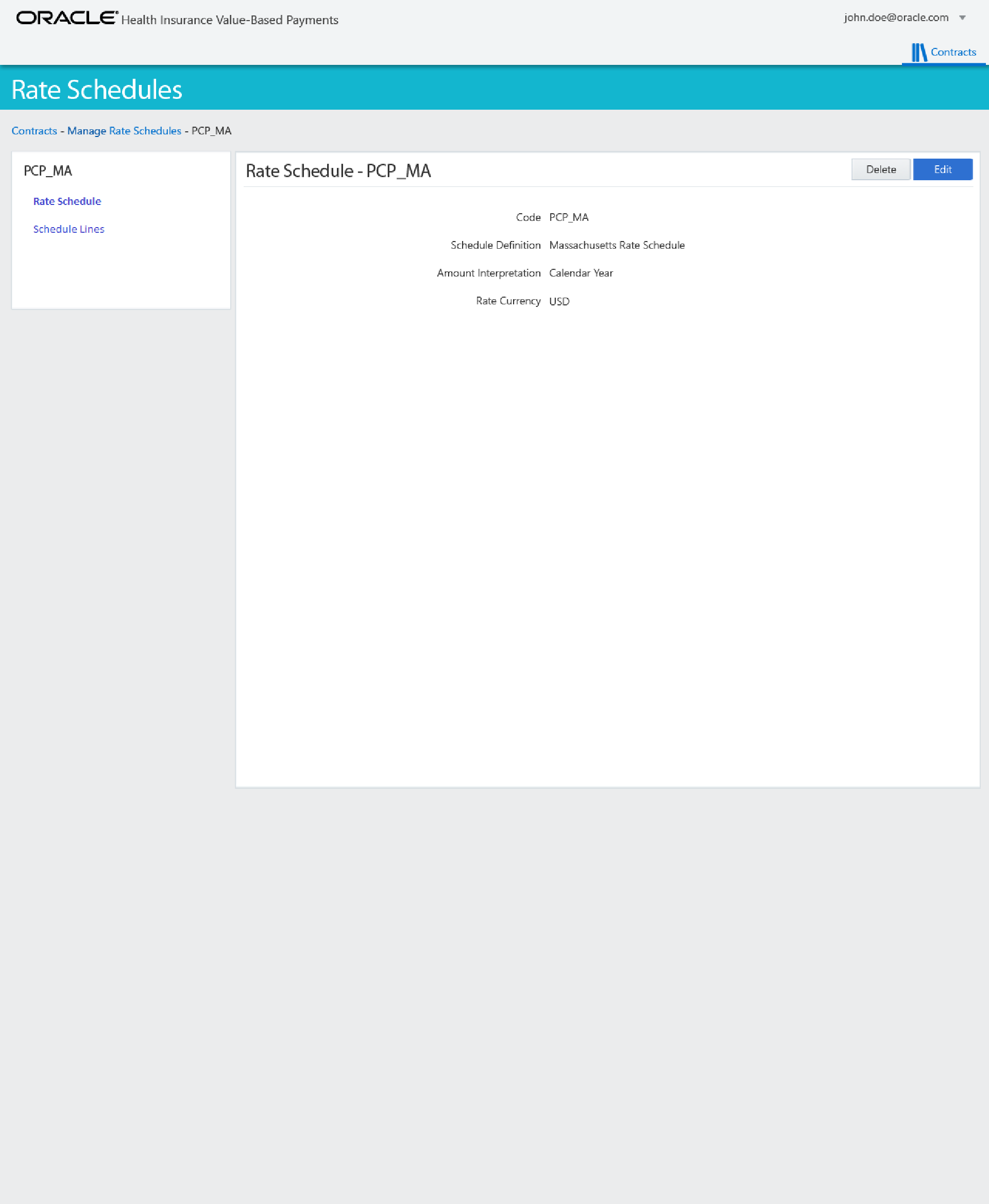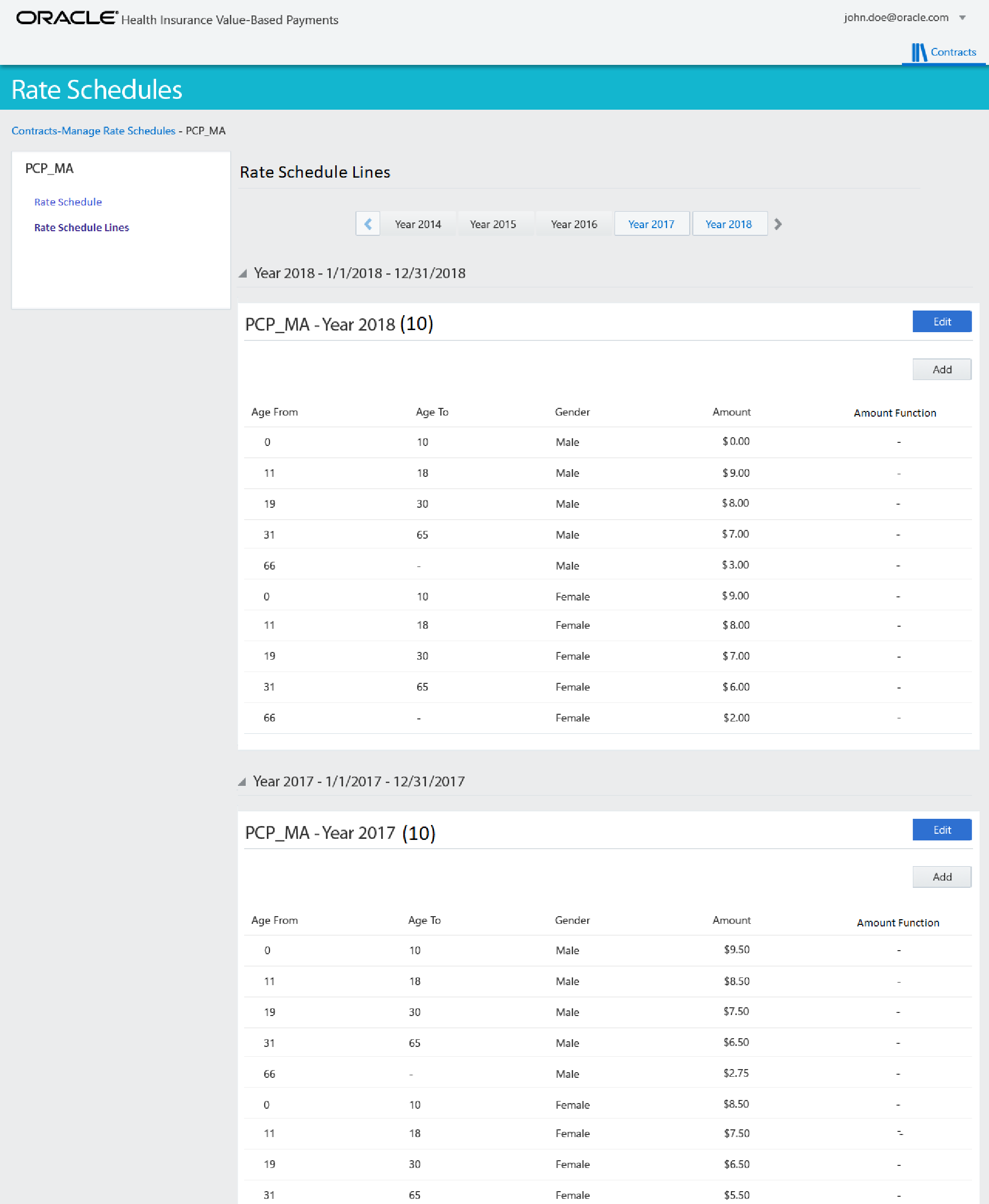Rate Schedules
A rate schedule is a reusable look-up table for rate amounts. It consists of a header (the rate schedule record) and one or more rate schedule lines. A rate schedule line consists of fields (columns) that represent conditions and a single rate amount field (including the currency) or function field to calculate the rate amount. This is the rate amount that applies if all the conditions on the line are met.
The rate schedule header always refers to a schedule definition. The schedule definition specifies which columns are available in the rate schedule (refer to Schedule Definitions for more information). In addition to the columns specified in the schedule definition, each rate schedule line has a rate amount (including the currency), or a dynamic logic function that calculates the rate amount. The rate schedule header has the following fields:
| Field | Description |
|---|---|
Code |
The functional identifier of this rate schedule |
Schedule Definition |
The schedule definition on which the rate schedule is based (the schedule definition for a rate schedule must be of type Rate) |
Amount Interpretation |
The way amounts are interpreted (per Calendar Year or per Contract Calculation Period) |
Rate Currency |
The currency of the rate amounts in the rate schedule (all rate schedule lines in the rate schedule have the same rate currency); currencies (with fields code, display code, description and default indicator) are configured separately |
A rate schedule line has at the following fields:
| Field | Description |
|---|---|
Rate Schedule |
The rate schedule to which this rate schedule line belongs |
Default Time Period |
The default time period to which this rate schedule line belongs |
Amount |
The rate amount that applies if all the conditions on this line are met |
Currency |
The currency of the rate amount (this field is read-only; it is automatically set to the rate currency specified on the rate schedule when the amount is specified) |
Amount Function |
Dynamic logic function to calculate the rate amount |
Including any additional dimensions (see table below) specified by the schedule definition |
|
Note that exactly one of amount and function must be specified.
The values for the additional dimensions specified by the schedule definition are stored in schedule dimension values. A schedule dimension value has the following fields:
| Field | Description |
|---|---|
Rate Schedule Line |
The rate schedule line to which the value belongs |
Schedule Dimension |
The reference to the schedule dimension |
Value (amount, char, date or nr) From |
The schedule dimension value from (if the dimension is of type Value, then this will store the exact value) |
Value (amount) From Currency |
The currency of the amount from value (only applies to dimensions of datatype Amount) |
Value (amount, char, date or nr) To |
The schedule dimension value to (only applies to dimensions with usage Range) |
Value (amount) To Currency |
The currency of the amount to value (only applies to dimensions of datatype Amount) |
User Interface
The UI consists of a search page and a rate schedule page to maintain rate schedule details and schedule lines. Retrieval of data in these pages is subject to restrictions. For details refer to the Access Restrictions page in the Operations Guide.
Search Page
The user can use the Quick Search field to search for rate schedules based on their code. The user can use the Advanced Search field to search for rate schedule based on their schedule definition and amount interpretation.
Search results display the code, amount interpretation, schedule definition and currency.
By clicking on a search result line the rate schedule page opens with the selected rate schedule in context.

Rate Schedule Page
This displays a single rate schedule. The page can be accessed through the search page by clicking one of the search results or directly with the associated URL.
The rate schedule page displays the following links:
-
Rate Schedule
-
Schedule Lines
Rate Schedule
This is the landing page and provides an overview of the rate schedule. It is possible for a user to view and edit rate schedule attributes here. It is based on the JET page template 'Hierarchical Recursive'. For more details on page templates, refer to the User Interface Patterns book.

Schedule Lines
This page provides an overview of the schedule lines applicable within the context of the time periods.
The available time periods are shown using the Conveyor Belt pattern as described by the JET Cookbook. The list is ordered based on the time period start date (ascending) and the last five periods are shown.
For a selected time period, the next section shows the schedule lines that are within its context. This section is shown in the view mode by default. Action ‘Edit’ makes the section editable. The user can now edit the schedule lines.
- Comparing Schedule Lines
-
This page provides the ability to compare schedule lines within the context of different time periods.
Selecting more than one period, shows schedule lines within the context of the selected time periods. The schedule lines are bounded by a collapsible header displaying the time periods display name, start and end date.
The schedule lines section is closed when a user clicks on a previously selected time period. Note that if there are outstanding changes in the section being closed, then the user is prompted to either save or cancel the changes. The actions save and cancel are scoped only for the section that is being closed.
Image showing schedule lines over two different time periods being compared.

Access Restrictions
Appropriate access grants must be provided to a user to be able to create, view and edit a rate schedule.
-
Function Access grant to CP0010. This enables a user to access the search and rate schedule page to perform view, update and create. For details refer to Function Access Restrictions of the User Interface Patterns book.
-
The search and rate schedule page uses HTTP API generic resources to perform DML and therefore, appropriate grants to GET (to view), POST (to create), PUT (to update), PATCH (to update) and DELETE (to delete) operations must be granted to the rateschedule resource.
-
The user must have access grant to GET operation for the following resources for LOVs to work:
Example
This example shows the configuration of a rate schedule where the rates are based on the member’s age.
The first step is to set up a default time period for which the rate amounts apply.
Default Time Period
| Display Name | Start Date | End Date |
|---|---|---|
Calendar Year 2017 |
2017-01-01 |
2017-12-31 |
More default time periods can be set up later, for example, to specify rate amounts for calendar year 2018.
The second step is to set up the logic that compares the member’s age to the values in the rate schedule lines.
Dynamic Logic Condition
| Code | Logic |
|---|---|
RSLE MEM AGE |
def age = attribution.memberContractCalculationPeriod.person.getAge(referenceDate) return rateScheduleLine.memberAge?.fromValue !=null && age >= rateScheduleLine.memberAge?.fromValue && (age ⇐rateScheduleLine.memberAge?.toValue || rateScheduleLine.memberAge?.toValue == null) |
The next step is to set up a schedule definition. The schedule definition controls which columns the rate schedule shows in addition to the rate. To add a column for the member age range, add a single dimension. The dimension field name has to be the same as the name the one used in the dynamic logic condition, that is, rateScheduleLine.memberAge.
Schedule Definition
| Code | Description | Type | Condition |
|---|---|---|---|
AGE BASED |
Member age based rates |
Rate |
RSLE MEM AGE |
Schedule Dimensions
| Display Name | Field Name | Type | Usage |
|---|---|---|---|
Member Age |
memberAge |
Generic (nr) |
Range |
The next step is to set up a rate schedule, based on the configured schedule definition.
Rate Schedule
| Code | Schedule Definition | Amount Interpretation | Currency |
|---|---|---|---|
AGE BASED RATES |
AGE BASED |
Contract Calculation Period |
$ |
Rate Schedule Lines
| Member Age From | Member Age Through | Rate |
|---|---|---|
0 |
18 |
15.00 $ |
19 |
64 |
20.00 $ |
65 |
25.00 $ |
The rate schedule is now complete, but it won’t be applied in the capitation calculation until it is attached to a contract. Refer to the scenarios described in the Capitation Contracts page of the Operations Guide for examples of rate schedules that are used by capitation contracts.